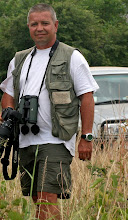
We arrived at what is known between birders as the "School Trail" which goes through a patch of forest along a wide path to the edge of the forest. This trail also leads to one of the local schools and used by school children and the community, hence the name. Walking down the trail, one overlooks some canopy on the left whilst looking up on the right into forest. Not overly dense and also with some vegetation on the trail level, the altitude here of c. 2600m makes it ideal for Albertine Rift Endemics that don't occur at the lower altitudes of Buhoma.
We met Ugandan birding guide Emmanuel and his client there (whom I'd been birding with in Minziro Forest, Tanzania) who were staying at Trekker's Tavern nearby. The specials and endemics came rapidly (with a host of "normal" ones as well of course) with Grey Cuckoo-shrike, Mountain Masked Apalis, Grauer's Warbler, Ashy Flycatcher, Stripe-breasted Tit, Chestnut-throated Apalis, Luhder's Bush-shrike, Montane Oriole, Northern Puffback, Sharpe's Starling, Strange Weaver (2 adults and a juvenile), Yellow-streaked Greenbul (nesting) and African Paradise Flycatcher (also nesting - photo above). A Carruther's Mountain Squirrel (photo below) was the only mammal during the birding.
Chatting to Emmanuel and his client, we learnt that they'd seen the African Green Broadbill down at Mubwindi Swamps the previous day. Byron and I debated our timeframe for getting back to Rwanda and decided that we'll stay one night at Trekker's Tavern and see if can get a chance to see the broadbill. Worst case scenario would be some early morning birding at the School Trail (as if that's a bad thing). (photo left: Yellow-whiskered Greenbul)
Byron and I debated our timeframe for getting back to Rwanda and decided that we'll stay one night at Trekker's Tavern and see if can get a chance to see the broadbill. Worst case scenario would be some early morning birding at the School Trail (as if that's a bad thing). (photo left: Yellow-whiskered Greenbul)
 Byron and I debated our timeframe for getting back to Rwanda and decided that we'll stay one night at Trekker's Tavern and see if can get a chance to see the broadbill. Worst case scenario would be some early morning birding at the School Trail (as if that's a bad thing). (photo left: Yellow-whiskered Greenbul)
Byron and I debated our timeframe for getting back to Rwanda and decided that we'll stay one night at Trekker's Tavern and see if can get a chance to see the broadbill. Worst case scenario would be some early morning birding at the School Trail (as if that's a bad thing). (photo left: Yellow-whiskered Greenbul)The afternoon, most of the birders at Trekker Tavern set off to the School Trail including Herbert Byurahanga and his group. Byron and I did a brief sortie down the main road first where we got great views of 4 Crowned Hornbills and some Black & White Colobus monkeys. Back at the School Trail things were hotting up with species coming out in rapid mode again; White-starred Robin, Grauer's Warbler, Ruwenzori Apalis, Regal Sunbird, Chinspot Batis, White-tailed Blue Flycatcher, Collared Sunbird, Strange and Baglafecht Weavers, Mountain Illadopsis, Black Cuckoo and a Stripe-breasted Tit (a ringed adult - part of a research project on their nesting).
Willcock's Honeyguide made a spectacular appearance slightly downhill from us but great views with Sykes (Blue) Monkeys in the distance. Ruwenzori Batis was obliging followed by White-browed Crombec, Hill Babbler, Northern Puffback and Mountain Masked Apalis. Luhder's Bush-shrike (photo at right) appeared again with a Dusky Turtle Dove flying over as a finale.
Happy chappies and all, we returned to the lodge for a celebratory drink, hot shower and some good food. Chatting with everyone here, also Saul (Ugandan birding guide we'd met in Buhoma a couple of days earlier) with his clients who had seen the broadbill at a confirmed nesting area the day before, said that we could do the trek on a "quick in & out" which would be about 2.5 hours. We were going to "risk' it and see what happens.
African Stonechat at Trekker's Tavern

2.jpg)



























+(Akagera+NP).jpg)

